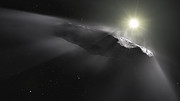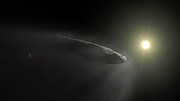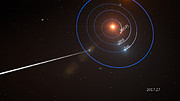Predicted position of `Oumuamua versus observed position
Videos
ESOcast 167: VLT sees `Oumuamua getting a boost
Animation of `Oumuamua outgassing
Animation of `Oumuamua outgassing and rotating
Animation of `Oumuamua passing through the Solar System
Animation of `Oumuamua passing through the Solar System (annotated)
Animation showing the expected and measured trajectory of `Oumuamua
New results indicate interstellar nomad `Oumuamua is a comet
`Oumuamua, the first interstellar object
discovered in the Solar System, is moving away from the Sun faster than
expected. This anomalous behaviour was detected by a worldwide
astronomical collaboration including ESO’s Very Large Telescope in
Chile. The new results suggest that `Oumuamua is most likely an
interstellar comet and not an asteroid. The discovery appears in the
journal Nature.
`Oumuamua — the first interstellar object discovered within our Solar System — has been the subject of intense scrutiny since its discovery in October 2017 [1]. Now, by combining data from the ESO’s Very Large Telescope
and other observatories, an international team of astronomers has found
that the object is moving faster than predicted. The measured gain in
speed is tiny and `Oumuamua is still slowing down because of the pull of
the Sun — just not as fast as predicted by celestial mechanics.
The team, led by Marco Micheli (European Space Agency)
explored several scenarios to explain the faster-than-predicted speed of
this peculiar interstellar visitor. The most likely explanation is that
`Oumuamua is venting material from its surface due to solar heating — a
behaviour known as outgassing [2].
The thrust from this ejected material is thought to provide the small
but steady push that is sending `Oumuamua hurtling out of the Solar
System faster than expected — as of 1 June 2018 it is traveling at
roughly 114 000 kilometres per hour.
Such outgassing is a behaviour typical for comets
and contradicts the previous classification of `Oumuamua as an
interstellar asteroid. “We think this is a tiny, weird comet,” commented
Marco Micheli. “We can see in the data that its boost is getting smaller the farther away it travels from the Sun, which is typical for comets.”
Usually, when comets are warmed by the Sun they eject dust and gas, which form a cloud of material — called a coma — around them, as well as the characteristic tail. However, the research team could not detect any visual evidence of outgassing.
“We did not see any dust, coma, or tail, which is unusual,”
explained co-author Karen Meech of the University of Hawaii, USA. Meech
led the discovery team’s characterisation of `Oumuamua in 2017. “We think that ‘Oumuamua may vent unusually large, coarse dust grains.”
The team speculated that perhaps the small dust grains adorning the
surface of most comets eroded during `Oumuamua’s journey through
interstellar space, with only larger dust grains remaining. Though a
cloud of these larger particles would not be bright enough to be
detected, it would explain the unexpected change to ‘Oumuamua’s speed.
Not only is `Oumuamua’s hypothesised outgassing an unsolved
mystery, but also its interstellar origin. The team originally
performed the new observations on `Oumuamua to exactly determine its
path which would have probably allowed it to trace the object back to
its parent star system. The new results means it will be more
challenging to obtain this information.
“The true nature of this enigmatic interstellar nomad may remain a mystery,” concluded team member Olivier Hainaut, an astronomer at ESO. “`Oumuamua’s
recently-detected gain in speed makes it more difficult to be able to
trace the path it took from its extrasolar home star.”
Notes
[1]`Oumuamua, pronounced “oh-MOO-ah-MOO-ah”, was first discovered using the Pan-STARRS telescope at the Haleakala Observatory, Hawaii. Its name means “scout” in Hawaiian, and reflects its nature as the first known object of interstellar origin to have entered the Solar System. The original observations indicated it was an elongated, tiny object whose colour were similar to that of a comet.
Notes
[1]`Oumuamua, pronounced “oh-MOO-ah-MOO-ah”, was first discovered using the Pan-STARRS telescope at the Haleakala Observatory, Hawaii. Its name means “scout” in Hawaiian, and reflects its nature as the first known object of interstellar origin to have entered the Solar System. The original observations indicated it was an elongated, tiny object whose colour were similar to that of a comet.
[2] The team tested several
hypothesis to explain the unexpected change in speed. They analysed if
solar radiation pressure, the Yarkovsky effect, or friction-like effects
could explain the observations. It was also checked if the gain in
speed could have been caused by an impulse event (such as a collision),
by `Oumuamua being a binary object or by `Oumuamua being a magnetised
object. The unlikely theory that `Oumuamua is an interstellar spaceship
was also rejected: the facts that the smooth and continuous change in
speed is not typical for thrusters and that the object is tumbling on
all three axis speak against it being an artificial object.
More Information
More Information
The research team’s work is presented in the scientific
paper “Non-gravitational acceleration in the trajectory of 1I/2017 U1
(`Oumuamua)”, which will be published in the journal Nature on 27 June 2018.
The international team of astronomers in this study
consists of Marco Micheli (European Space Agency & INAF, Italy),
Davide Farnocchia (NASA Jet Propulsion Laboratory, USA), Karen J. Meech
(University of Hawaii Institute for Astronomy, USA), Marc W. Buie
(Southwest Research Institute, USA), Olivier R. Hainaut (European
Southern Observatory, Germany), Dina Prialnik (Tel Aviv University
School of Geosciences, Israel), Harold A. Weaver (Johns Hopkins
University Applied Physics Laboratory, USA), Paul W. Chodas (NASA Jet
Propulsion Laboratory, USA), Jan T. Kleyna (University of Hawaii
Institute for Astronomy, USA), Robert Weryk (University of Hawaii
Institute for Astronomy, USA), Richard J. Wainscoat (University of
Hawaii Institute for Astronomy, USA), Harald Ebeling (University of
Hawaii Institute for Astronomy, USA), Jacqueline V. Keane (University of
Hawaii Institute for Astronomy, USA), Kenneth C. Chambers (University
of Hawaii Institute for Astronomy, USA), Detlef Koschny (European Space
Agency, European Space Research and Technology Centre, & Technical
University of Munich, Germany), and Anastassios E. Petropoulos (NASA Jet
Propulsion Laboratory, USA).
ESO is the foremost intergovernmental astronomy organisation in Europe and the world’s most productive ground-based astronomical observatory by far. It has 15 Member States: Austria, Belgium, the Czech Republic, Denmark, France, Finland, Germany, Italy, the Netherlands, Poland, Portugal, Spain, Sweden, Switzerland and the United Kingdom, along with the host state of Chile and with Australia as a strategic partner. ESO carries out an ambitious programme focused on the design, construction and operation of powerful ground-based observing facilities enabling astronomers to make important scientific discoveries. ESO also plays a leading role in promoting and organising cooperation in astronomical research. ESO operates three unique world-class observing sites in Chile: La Silla, Paranal and Chajnantor. At Paranal, ESO operates the Very Large Telescope and its world-leading Very Large Telescope Interferometer as well as two survey telescopes, VISTA working in the infrared and the visible-light VLT Survey Telescope. ESO is also a major partner in two facilities on Chajnantor, APEX and ALMA, the largest astronomical project in existence. And on Cerro Armazones, close to Paranal, ESO is building the 39-metre Extremely Large Telescope, the ELT, which will become “the world’s biggest eye on the sky”.
Links
- Images of Hubble
- Hubblesite release
- ESA/Hubble press release
- Institute for Astronomy (University of Hawaii) press release
- Canada-France-Hawaii Telescope press release
- European Space Agency press release
- TED talk by Karen Meech
- Nature Blog post by Olivier Hainaut
- Science paper
- Press release about the discovery of `Oumuamua
Contacts:
Olivier Hainaut
European Southern Observatory
Garching, Germany
Tel: +49 89 3200 6752
Email: ohainaut@eso.org
Marco Micheli
Space Situational Awareness Near-Earth Object Coordination Centre, European Space Agency
Frascati, Italy
Tel: +39 06 941 80365
Email: marco.micheli@esa.int
Karen Meech
Institute for Astronomy, University of Hawaii
Honolulu, USA
Cell: +1 720 231 7048
Email: meech@IfA.Hawaii.Edu
Richard Hook
ESO Public Information Officer
Garching bei München, Germany
Tel: +49 89 3200 6655
Cell: +49 151 1537 3591
Email: pio@eso.org
Source: ESO/News


















